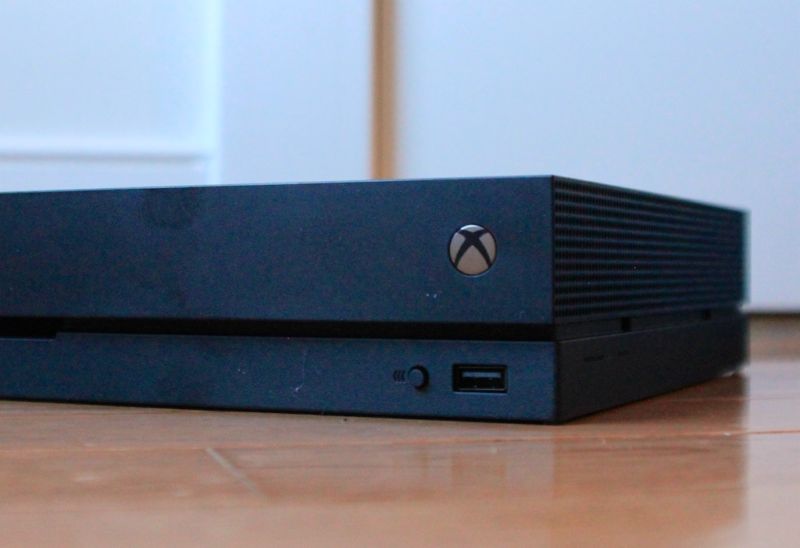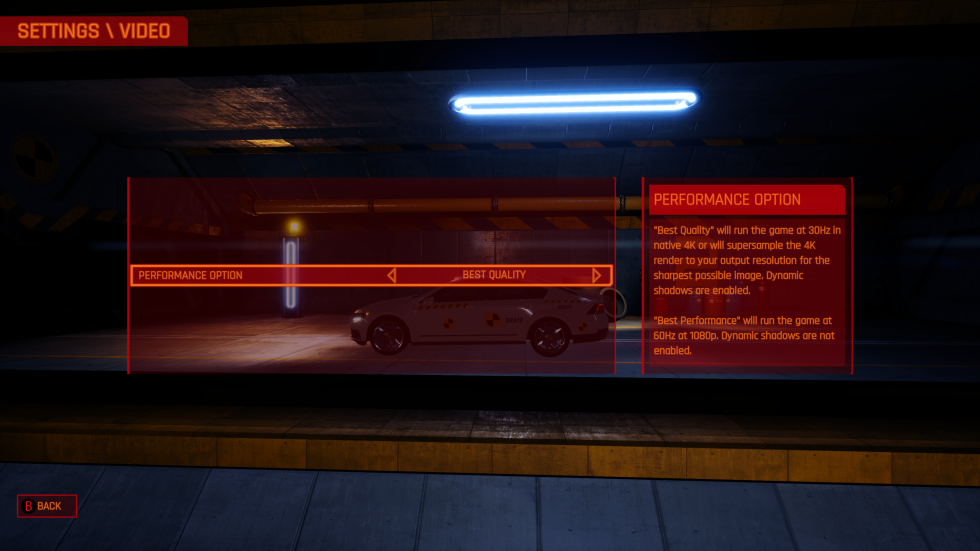
When it comes to seeing the value of that hardware on the screen, though, the promise of the Xbox One X is currently unfulfilled—at the very least, it's incomplete. We’ve only been able to test a relative handful of games that have gotten a downloadable patch providing the full “Xbox One X enhanced” treatment as of press time. That list excludes high-profile exclusives like Forza Motorsport 7 and Halo 5, as well as major cross-console comparisons like Rise of the Tomb Raider or Middle-Earth: Shadow of War.
| Spec Comparison | ||||
|---|---|---|---|---|
| PS4 (non-Slim) | PS4 Pro | Xbox One (non-S) | Xbox One X | |
| GPU | 18 Radeon GCN CUs @ 800 Mhz | 36 improved GCN CUs @ 911 Mhz | 12 custom AMD CUs @ 911 Hmz | 40 custom AMD CUs @ 1172 Mhz |
| CPU | 8 Jaguar cores @ 1.6Ghz | 8 Jaguar cores @ 2.1Ghz | 8 Jaguar cores @ 1.75 Ghz | 8 Jaguar cores @ 2.3 Ghz |
| GPU teraflops | 1.8 | 4.2 | 1.4 | 6 |
| RAM | 8GB GDDR5 | 8GB GDDR5 (+1GB DDR3) | 8GB DDR3 (+32MB eSRAM) | 12GB GDDR5 |
| Memory bandwidth | 176 GB/s | 218 GB/s | 68 GB/s (218 GB/s for eSRAM) | 326 GB/s |
| Max power consumption (gameplay) | 148W (79W for PS4 Slim) | 154W (4K gaming) | 120W (79W for One S) | 143W (4K gaming) |
| USB ports | 2 USB 3.0 ports | 3 USB 3.0 ports | 3 USB 3.0 ports | 3 USB 3.0 ports |
| Hard drive | 500GB to 1TB | 1TB | 500GB to 1TB | 1TB |
| Size (widest points) | 275 x 53 x 305mm (10.8 x 2.1 x 12") | 295 x 55 x 327mm (11.6 x 2.2 x 12.9") | 333 x 274 x 89 mm (13.1 x 10.8 x 3.1") | 300 x 240 x 60mm (11.8 x 9.4 x 2.4") |
| MSRP | $250 - $300 (w/ bundled game) | $400 | $250 - $300 (w/ bundled game) | $500 |
While Microsoft promises similar enhancements for dozens of games are in the pipeline (including 70 titles that should be enhanced “right around release”), most publishers seem to need more time to adapt their titles to use the full power out of the system. That’s a bit concerning, especially when considering how long Microsoft has been gearing up for its big 4K play.
For the games we have tested, the value of those enhancements varies greatly depending on the specific software and your specific living room setup. Enhanced games we’ve tried definitely look and perform better on the One X, but it’s often hard to suggest they perform $500 better on a 4K display (or even $250 better, if you’re coming into the Xbox ecosystem fresh). And if you don’t have a TV that supports 4K and/or HDR colors, the improvements are much more marginal.So as with the PS4 Pro, the lack of any exclusive software that needs the One X hardware means Microsoft’s best competition is the older console that runs the very same set of games at acceptable levels.
How you know it's an X
| Xbox One X power usage | |
|---|---|
| Standby Mode (energy saving) | 1W |
| Standby Mode (instant-on) | 36W |
| Standby Mode (w/ download | 41-54W |
| Idle on home menu | 62W |
| Downloading game from menu | 64W |
| Netflix | 65W |
| 4K Blu-ray disc | 66W |
| Gaming (Assassin's Creed Black Flag @ 1080p) | 102W (menu), 119W (gameplay) |
| Gaming (Super Lucky's Tale @ 4K) | 98W (cut scene), 143W (gameplay) |
Upon your first power-on of the Xbox One X, you'll know it's all X'ed out in two ways. First, the booting sequence now has a brief flash of microchips and DIMM modules whizzing past like something out of a cheesy '80s movie—which apparently is meant to represent the added power inside the Xbox One X. Otherwise, all system menus look exactly like the ones you'll find on other Xbox models (with an optional 4K resolution, just like on Xbox One S). It's worth noting that Microsoft has been diligently updating the console's menus over the past few years. If you haven't hopped on an Xbox One in a while, you'll be happy to know that its "home" interface is now far more streamlined and that a single tap of the big "Xbox" button finally brings up a quick-options menu like the one we loved so much on Xbox 360.
There is a second tell, however, and it's one that even PlayStation 4 Pro doesn't have: a toggle in its "games and apps" menu that lets you sort by "Xbox One X Enhanced Games." Doing this doesn't tell you exactly how each game you have installed is enhanced, but at least Microsoft leaves players without a doubt that, yes, your game has (or has not) been patched with Xbox One X in mind.
Highly Dynamic Colors
There’s a lot to be said about HDR (and we’ve sure said it), but the biggest takeaway to currently emphasize is this: 4K resolution and HDR boosts need each other to look their best. HDR’s jump in wow factor and color impact truly depends on the number of pixels it’s working with. Xbox One X, like the PlayStation 4 Pro before it, unifies these two standards to give you full-fat video games with that visual PB+chocolate combo: more pixels smothered in more HDR-10 color/luminance data.The last system revision, the Xbox One S, brought with it very limited implementations of two rising TV standards, 4K and HDR. 4K was limited solely to non-gameplay content like streaming apps, 4K Blu-ray, and menu text. The One S’ HDR boosts to gamut range and luminance, on the other hand, began rolling out to a very limited set of Xbox One games, but these only operated at a maximum 1080p resolution.Owners of HDR-compatible TVs should temper their expectations for the pop on Xbox One X games in general, though. Some “Xbox One X enhanced” games will technically get the HDR label to pop up on your TV screen, but these only deliver enhanced 10-bit color depth. This added color gamut doesn’t include the luminance data that helps make bright areas of a game scene really pop with extra light.
The lack of full HDR is most evident in Halo 3’s otherwise impressive update for the Xbox One X, which also includes a brand-new upsampling of its polygonal assets. The color data here is certainly broader with the update, and the color balance looks better than in the Halo: Master Chief Collection version, but the romps through jungles and military outposts still look a little flat without that heightened luminance range.
-
A comparison gallery of shots of the stock Xbox One and the Xbox One X (be sure to blow up full screen on a 4K HDR monitor to get the full effect, and step back to a living room viewing distance). Here's Gears of War 4 on Xbox One X...
-
...and a similar firefight on a stock Xbox One.
-
Hurling a grenade on Xbox One X...
-
...and on stock Xbox One.
-
Killer Instinct on the Xbox One X...
-
...and on the stock Xbox One. Note this game doesn't make use of HDR colors.
-
Mickey introduces you to Disneyland Adventures on the Xbox One X...
-
...and fewer Mickey pixels on stock Xbox One. ("Mick-sels"?)
-
Super Lucky's Tale on the Xbox One X...
-
...and on the stock Xbox One. Jagged lines on object edges are more prevalent here.
-
A dialog screen from Super Lucky's Tale on Xbox One X...
-
...and the same conversation in lower resolution on stock Xbox One.
-
Ziplining in Disney/Pixar's Rush on the Xbox One X...
-
...and on the Xbox One stock.
-
Woody finishes a level on the Xbox One X...
-
...and on the stock Xbox One.
FIFA 18 on Xbox One X comes with an even more underwhelming HDR boost, which suffers primarily because the game focuses its cameras on an evenly lit pitch. You’ll absolutely notice and appreciate the game’s 4K resolution boost—which comes without a hit to the frame rate and makes your tiny midfielders’ details stand out that much more. But even during replays when cameras point up at field lights and other dramatic lighting, everything’s still mapped to an “SDR” range of luminance.
Gears of War 4 fares much better—and, at this point, it's probably the system’s HDR TV showcase game. Dramatic color and lighting effects seem to jump off the screen when so much detail and so many particle effects are visible in the game’s 4K mode. Moonlit stealth-runs through enemy territory and rushes through lightning-singed sandstorms really stand out with a full HDR range of color and light. The design team at The Coalition has absolutely given this game a stronger once-over with HDR than I’d previously encountered at events last year.

(The Xbox One X version of Gears of War 4 also comes with the welcome option to choose a lower-resolution, 60 fps campaign mode if you don’t want the full 4K experience at a lower frame rate. It’s a nice choice to have, but the lower resolution really mutes the impact of the HDR colors. On the bright side, all multiplayer and Horde modes run at 4K and 60 fps by default, which means you don’t have to trade anything to get amazing performance and HDR benefits when playing online.)
While Forza Motorsport 7 hasn’t been enhanced on the Xbox One X as of this writing, we suspect it will look similar to the 4K and HDR-enhanced PC version that we’ve previously evaluated:Thanks to better optimization and higher resolution, details like headlights, reflected streetlights, and the bright sun look phenomenally better in the Windows 10 HDR version than on Xbox One S. However, the dramatic color tone I had hoped for, especially in-car paint jobs, is still lacking.
Those enhancements compare unfavorably to those in Gran Turismo Sport, whose HDR implementation was built from the ground up to look amazing on a 4K HDR screen. HDR’s artistic and rendering pipeline takes a lot of effort, so it shows when a game goes the extra mile for the tiny percentage of current players who can appreciate it.
reader comments
196